Gate of Hell Blu-ray Movie
HomeGate of Hell Blu-ray Movie 
地獄門 / JigokumonCriterion | 1953 | 89 min | Not rated | Apr 09, 2013
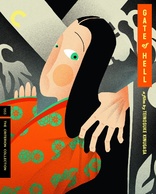
Movie rating
7.3 | / 10 |
Blu-ray rating
| Users | 0.0 | |
| Reviewer | 4.0 | |
| Overall | 4.0 |
Overview
Gate of Hell (1953)
In the midst of epic, violent intrigue in twelfth-century Japan, an imperial warrior falls for a lady-in-waiting; after he discovers she is married, he becomes frenzied in his attempts to win her love.
Starring: Kazuo Hasegawa, Machiko Kyô, Isao Yamagata, Yataro Kurokawa, Kôtarô BandôDirector: Teinosuke Kinugasa
| Foreign | Uncertain |
| Drama | Uncertain |
| Romance | Uncertain |
| War | Uncertain |
| History | Uncertain |
| Period | Uncertain |
Specifications
Video
Video codec: MPEG-4 AVC
Video resolution: 1080p
Aspect ratio: 1.37:1
Original aspect ratio: 1.37:1
Audio
Japanese: LPCM Mono (48kHz, 24-bit)
Subtitles
English
Discs
25GB Blu-ray Disc
Single disc (1 BD)
Playback
Region A (locked)
Review
Rating summary
| Movie | 4.5 | |
| Video | 5.0 | |
| Audio | 4.0 | |
| Extras | 1.0 | |
| Overall | 4.0 |
Gate of Hell Blu-ray Movie Review
Reviewed by Dr. Svet Atanasov March 15, 2013Winner of the prestigious Grand Prix Prize at the Cannes Film Festival, Japanese director Teinosuke Kinugasa's "Jigokumon" a.k.a "Gate of Hell" (1953) arrives on Blu-ray courtesy of Criterion. There are no supplemental features on this release. Included is an illustrated booklet featuring an essay by film historian Stephen Prince. In Japanese, with optional English subtitles for the main feature. Region-A "locked".

Lady Kesa
The Heiji Era, 1160. Nearby Sanjo Castle rebels and loyal to the Emperor samurai clash. Moments before the rebels storm the last stronghold, the Emperor’s father and sister are urged to leave. Hoping to distract the rebels, the leader of the samurai asks for a volunteer to be used as a decoy. The stunningly beautiful Lady Kesa (Machiko Kyo, Rashomon, Floating Weeds) agrees to be the 'sister', while the brave warrior Morito (Kazuo Hasegawa, The Tale of Genji, The Crucified Lovers) is chosen to be her protector.
Soon after, Lady Kesa’s carriage is attacked by the rebels, but Morito manages to escape with her. The two take shelter in his family home. Another warrior then arrives looking for Moritada (Kunitaro Sawamura), Morito's brother, who has apparently sided with the rebels. When Moritada also appears with a few of his men, he urges Morito to join the rebels but he refuses and they begin fighting. During the chaos, Lady Kesa disappears. Meanwhile, the Emperor’s father and sister are captured and beheaded at the Gate of Hell.
Morito travels to a nearby island to inform Lord Kiyomori (Koreya Senda) what has happened during his absence. Later on, after the rebels are defeated Lord Kiyomori decides to reward him for his bravery. Morito asks Lord Kiyomori to arrange his marriage with Lady Kesa, who is a lady-in-waiting at his court. Lord Kiyomori agrees to grant Morito's wish but is told that Lady Kesa is already married to Lord Watanabe Wataru (Isao Yamagata, Samurai Rebellion), the leader of the Imperial Guards. Convinced that they were meant to be together, Morito vows to make Lady Kesa his wife and unleashes a chain of tragic events.
Based on the play by Kan Kikuchi, Teinosuke Kinugasa’s Gate of Hell is a film of striking beauty. Lush colors often fill up the screen and select sequences truly look like moving pictures. Even the darker nighttime sequences - such as the one where Lord Watanabe Wataru and Lady Kesa are seen together in the garden - look notably elegant.
Unlike other similarly themed samurai films, Gate of Hell is virtually devoid of action. Honor and bravery are still important components in it, but the machoism that is often attached to them is missing. Especially during the second half there are plenty of romantic overtones that bring Gate of Hell a lot closer to being a period romantic film.
The dialog is simple but effective, effectively keeping the drama from sliding into melodrama. When Morito goes after the woman he is convinced he ought to spend the rest of his life with, he utters strong but believable words. His final encounter with Lord Watanabe Wataru is also filmed with a great sense of balance.
The emphasis on detail is excellent. Sanzo Wada's costume designs, in particular, are often striking. The production designs are by veteran specialist Kisaku Ito, known for his contributions to Kenji Mizoguchi’s Ugetsu Monogatari (1953) and Sansho the Bailiff (1954), Keisuke Kinoshita’s The Ballad of Narayama (1958) and The River Fuefuki (1960), and Hiroshi Inagaki’s Samurai I: Musashi Miyamoto(1954), Samurai II: Duel at Ichijoji Temple (1955), and Samurai III: Duel at Ganryu Island (1956). The film was lensed by cinematographer Kohei Sugiyama (Kenji Mizoguchi’s The 47 Ronin).
Note: Winner of Oscar Awards for Best Foreign Language Film and Best Costume Designs, Gate of Hell has been named by director Martin Scorsese as one of the ten most beautiful color films ever made.
Gate of Hell Blu-ray Movie, Video Quality 
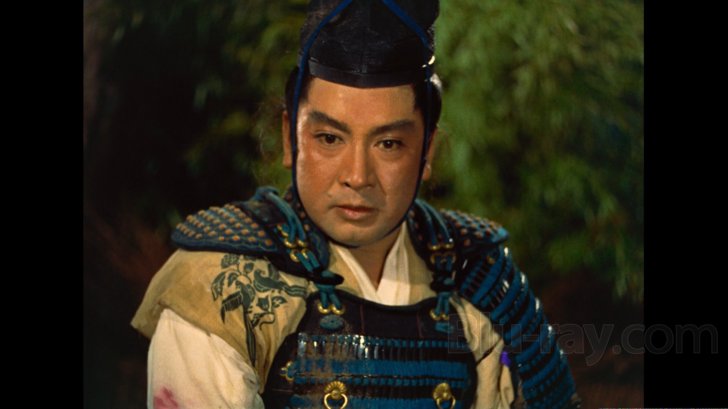
Presented in its original aspect ratio of 1.37:1, encoded with MPEG-4 AVC and granted a 1080p transfer, Teinosuke Kinugasa's Gate of Hell arrives on Blu-ray courtesy of Criterion.
The following text appears inside the booklet provided with this Blu-ray release:
"This new digital master was created from the 2011 2K restoration undertaken by the national Film Center of the National Museum of Modern Art in Tokyo and Kadokawa Shoten Co., Ltd., in cooperation with NHK. For the restoration, a new digital transfer, supervised by cameraman Fujio Morita, was created in 4K resolution on an IMAGER scanner at Imagica from a 35mm duplicate negative and several 35mm master positives; the original camera negative no longer exists.
Transfer supervisor: Fujio Morita.
Sound restoration supervisor: Mototsugi Hayashi."
The high-definition transfer uses as a foundation the recent restoration of Gate of Hell by The National Film Center of the National Museum of Modern Art, Tokyo and Kadokawa Shoten Co., LTD. in cooperation with NHK. The same restoration was also used for Eureka Entertainment's recent release. Unsurprisingly, the two releases look virtually identical. There are only two very small discrepancies that I noticed. On the Criterion release brightness levels appear to have been toned down a bit, but the difference is indeed so small that it is essentially irrelevant. The reds also feel marginally better saturated on the Criterion release, but again the difference is too small. Detail and depth are excellent. Clarity is also outstanding, with the daylight sequences in particular looking very impressive. There are no traces of problematic degraining and sharpening corrections. There are no serious stability issues either. Finally, there are no large cuts, debris, damage marks, or warps. All in all, the recent restoration of Gate of Hell has given the film a new life. I think that it looks absolutely spectacular in high-definition. (Note: This is a Region-A "locked" Blu-ray disc. Therefore, you must have a native Region-A or Region-Free PS3 or SA in order to access its content).
Gate of Hell Blu-ray Movie, Audio Quality 
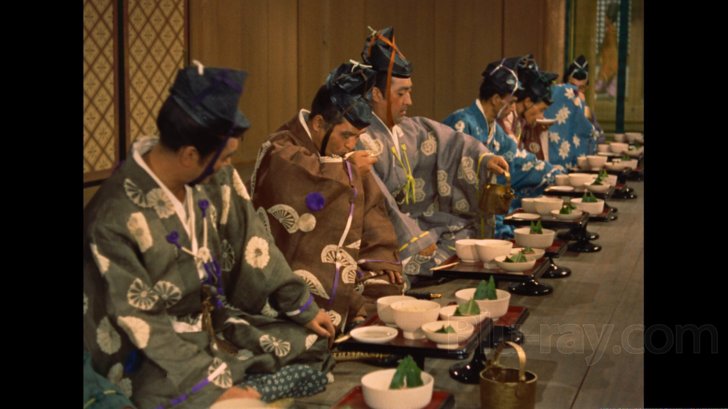
There is only one standard audio track on this Blu-ray disc: Japanese LPCM 1.0. For the record, Criterion have provided optional English SDH subtitles for the main feature.
The dialog is crisp and stable. Some extremely light background hiss occasionally sneaks in, but it never becomes distracting. Overall dynamic movement is rather limited, but this should not be surprising considering the age of the film and the conditions under which it was shot. There are no audio dropouts or distortions to report in this review. The English translation is very good.
Gate of Hell Blu-ray Movie, Special Features and Extras 
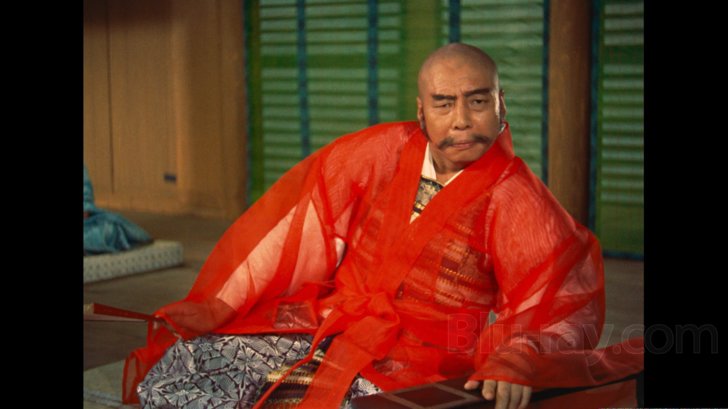
- Booklet - an illustrated booklet featuring an essay by film historian Stephen Prince.
Gate of Hell Blu-ray Movie, Overall Score and Recommendation 
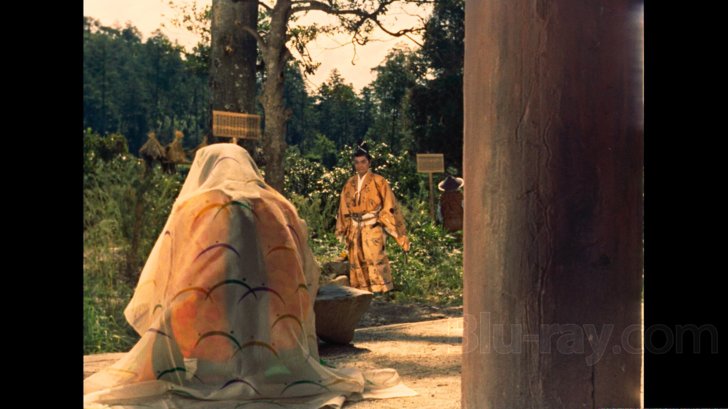
There is a good reason why Martin Scorsese has stated that Teinosuke Kinugasa's Gate of Hell is one of the ten most beautiful color films ever made - the film overflows with lush, at times overwhelmingly beautiful colors. Recently restored, Gate of Hell now also looks healthier than ever before. The story it tells is very simple, but it is profoundly moving. HIGHLY RECOMMENDED.
Similar titles
Similar titles you might also like

Kagemusha
影武者
1980

Sansho the Bailiff
山椒大夫 / Sanshô dayű
1954

Throne of Blood
蜘蛛巣城 / Kumonosu-jô
1957

The Ballad of Narayama
楢山節考 / Narayama bushikô
1958

The Little House
小さいおうち / Chiisai ouchi | Limited Edition to 3000
2014

Harakiri
切腹 / Seppuku
1962

Children of Paradise
Les enfants du paradis
1945

The Human Condition III: A Soldier's Prayer
人間の條件 / Ningen no jôken / Parts 5 and 6
1961

Ugetsu 4K
雨月物語 / Ugetsu monogatari
1953

Hiroshima mon amour
1959

City of Life and Death
南京!南京! / Nanjing! Nanjing!
2009

The Leopard
Il gattopardo / Italian and American Versions
1963

The Cranes Are Flying
Летят журавли / Letyat zhuravli
1957

Black Rain
Kuroi ame
1989

Kanal
1957

In the Fog
V tumane
2012

Floating Weeds
浮草
1959

The Makioka Sisters
細雪 / Sasame-yuki
1983

The Earrings of Madame de...
Madame de...
1953

Hara-Kiri: Death of a Samurai
一命 / Ichimei
2011